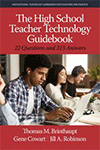
The High School Teacher Technology Guidebook
22 Questions and 313 Answers
By:
Thomas M. Brinthaupt, Middle Tennessee State University
Gene Cowart, Central Magnet High School, Murfreesboro, TN
Jill A. Robinson, Wellsville, NY, School District
A volume in the series: Instructional Technology Guidebooks for Educators and Parents. Editor(s): Thomas M. Brinthaupt, Middle Tennessee State University. Richard P. Lipka, St. Bonaventure University.
Published 2021
This guidebook is designed to be the high school teacher’s friend in addressing a wide variety of questions regarding the use of educational and instructional technologies. It can serve as a companion and guide through the myriad challenges and opportunities related to the effective use of technology in one’s classroom and school.
A sample of U.S. high school teachers provided us with detailed answers about their experiences with using technology in their teaching. Specifically, they shared their challenges, barriers, ideas, and suggestions for working successfully with administrators, technology specialists, students, fellow teachers, and parents when teaching with technology. We have organized the teachers’ experiences and recommendations according to each stakeholder group.
Rather than recommending or reviewing specific educational technology companies, applications, or tools, we provide a large number of strategies that are “built to last” and should be applicable regardless of the specific tool under consideration. We assume that it doesn’t ultimately matter what the tool or technology is that you’re using—it’s how and why you’re using it for teaching and learning that will determine whether it is successful or not. The “how” and “why” aspects encompass the built-to-last strategies included in this guidebook.
CONTENTS
PREFACE: Introduction to the Guidebook. PART I: TECHNOLOGY QUESTIONS AND ISSUES WHEN WORKING WITH SCHOOL/DISTRICT ADMINISTRATION CHAPTER 1: What can I do if I’m not permitted to download an app or use a program or resource? CHAPTER 2: What can I do to get a tool or technology approved for use? CHAPTER 3: What can I do to ensure that my students can access blocked sites or materials? CHAPTER 4: What can I do to ensure that I have a voice in my district’s or building’s technology decisions? CHAPTER 5: Are there good strategies for my school or district to use to introduce new technologies? PART II: TECHNOLOGY QUESTIONS AND ISSUES WHEN WORKING WITH TECHNOLOGY SPECIALISTS CHAPTER 6: What should I do if I don’t have a tech person (or my tech person cannot help me)? CHAPTER 7: How can I work best with my tech specialist? CHAPTER 8: How can I get my system or school to hire qualified tech specialists who can work well with my colleagues and me? PART III: TECHNOLOGY QUESTIONS AND ISSUES WHEN WORKING WITH STUDENTS CHAPTER 9: How can I work with my students to help me solve a classroom technology issue? CHAPTER 10: How can I manage my students’ use of their personal devices while in class? CHAPTER 11: How can I utilize my students’ personal devices and other technology to drive instruction? CHAPTER 12: How can I effectively monitor or control what my students will access with their devices while in class? PART IV: TECHNOLOGY QUESTIONS AND ISSUES WHEN WORKING WITH FELLOW TEACHERS CHAPTER 13: How can I benefit from the technology experiences and expertise of my fellow teachers? CHAPTER 14: How can I best share my technology experiences and expertise with my fellow teachers? CHAPTER 15: How can I get my school or district to harness the technology experiences and expertise of my fellow teachers? PART V: TECHNOLOGY QUESTIONS AND ISSUES WHEN WORKING WITH PARENTS CHAPTER 16: What can I do about my students not having home Internet or computer access? CHAPTER 17: What can I do to inform parents about how I am teaching with technology? CHAPTER 18: How can I work with parents to enhance my teaching with technology? CHAPTER 19: What can I do when my students’ parents have questions or concerns about my teaching with technology? PART VI: SOLVING TECHNOLOGY QUESTIONS AND ISSUES ON YOUR OWN CHAPTER 20: How can I decide to use a specific technology? CHAPTER 21: How can I get more proficient with different educational technologies? CHAPTER 22: How can I use my limited time to learn more about teaching with technology? PART VII: SUPPLEMENTAL RESOURCES. ABOUT THE AUTHORS.
-
Paperback978-1-64802-474-0
Web price: $45.04 (Reg. 52.99)
-
Hardcover978-1-64802-475-7
Web price: $80.74 (Reg. 94.99)
- eBook978-1-64802-476-4

- EDU029020 - EDUCATION: TEACHING METHODS & MATERIALS: Reading & Phonics
- EDU039000 - EDUCATION: Computers & Technology
- EDU001020 - EDUCATION: ADMINISTRATION: Elementary & Secondary
-
 Effects of Government Mandates and Policies on Public Education in Africa, the Caribbean, and the Middle East
Effects of Government Mandates and Policies on Public Education in Africa, the Caribbean, and the Middle East
-
 Innovations in Computational Intelligence, Big Data Analytics and Internet of Things
Innovations in Computational Intelligence, Big Data Analytics and Internet of Things
-
 Machine Learning, Natural Language Processing, and Psychometrics
Machine Learning, Natural Language Processing, and Psychometrics
-
 Middle Grades Research Journal
Volume 13 #2
Middle Grades Research Journal
Volume 13 #2
-
 Professional Learning Journeys of Teacher Educators
Professional Learning Journeys of Teacher Educators
-
 The Elementary School Teacher Technology Guidebook
21 Questions and 282 Answers
The Elementary School Teacher Technology Guidebook
21 Questions and 282 Answers
-
 The Middle-Level Teacher Technology Guidebook
20 Questions and 260 Answers
The Middle-Level Teacher Technology Guidebook
20 Questions and 260 Answers

